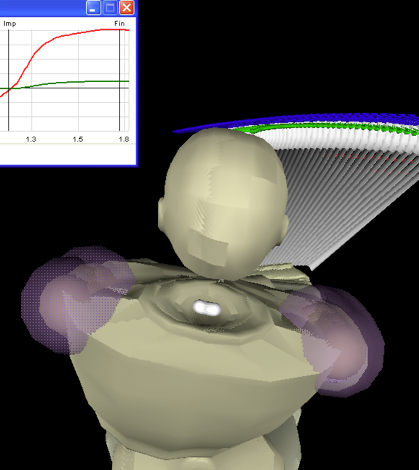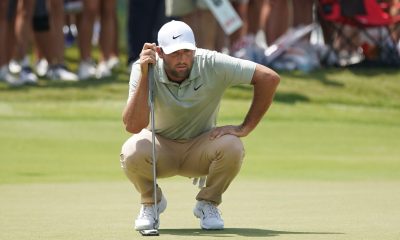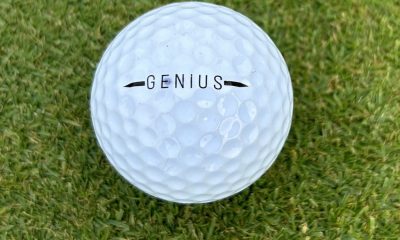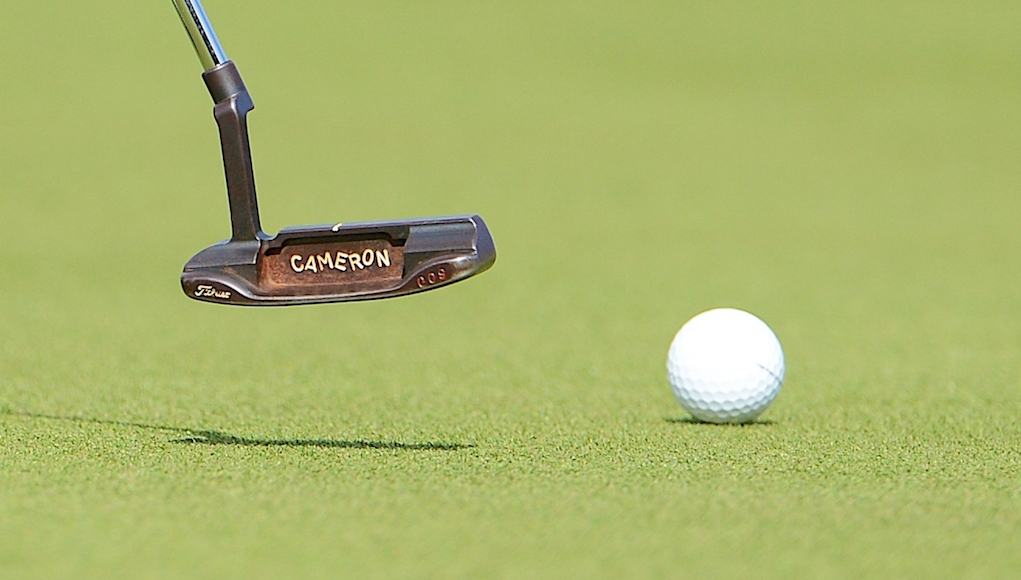Instruction
Problematic head motion during the putting stroke

As we all know, putting requires a solid stroke, a stable body and very controlled motor motions in order to be consistent from day to day. It is with this thought in mind that most players focus on keeping a steady head in order to keep their stroke in check when things go wrong. Within this putting study we will examine the most common problems that excessive head motion causes and how to ensure that a controllable center of gravity (CG) and a steady head becomes one of your strongest putting attributes.
In my putting academy, I use several high tech tools in order to study the putting stroke. In this article I will feature two of my systems:
- Advanced Motion Measurement’s 3D Motion Analysis System
- The SAM PuttLab created by Science & Motion Sports.
AMM’s 3D Motion Analysis System for Putting
The SAM shows over 28 different factors of the putter’s motions during the stroke
If you think about how your body moves during the putting stroke you will find that in order to maintain stability it is necessary to control your head as well as your CG. Whenever the head moves excessively during the putting stroke you will find that your stroke path, your directional control, and the ball’s impact point on the putterface will be compromised. When your body senses these actions it will subconsciously try and manipulate your hands, the putterhead, your body’s CG and/or the ball’s position in order to try to get your putting back on track quickly.
The reason why you subconsciously adjust for poor balance is because your body has homeostatic mechanisms that keep you upright and from falling down. These actions are present within your life every second of the day. This automated response helps us while walking, sitting, or playing golf — the more complex the motor skill, the more important this reaction becomes.
Homeostasis is controlled by the information given to your brain by your vision and the fluid filled canals within each of your ears. These balance centers allow your body to counter balance itself when things happen to alter your CG, such as excessive head motion. To give you an example, if I pushed your head and upper torso quickly to the right, your spine would shift your hips to the left in order to counter-balance your body so you would not fall down. This is homeostasis and it applies to your golf swing, short game and putting stroke equally.
As we all know, putting is one of the most precise actions in the game of golf. If your head is bouncing around, it makes it almost impossible to maintain your CG control and this throws a monkey wrench in your game. Whenever you call upon your homeostasis to help you control excessive motion while trying to make putts, I will assure you that rolling in that 4 footer will be your body’s last priority.
There are four head motions that plague most golfers today.
From the Frontal View:
Head Sway: The side-to-side motion of the head (lateral)
Head Rotation: The turning of the head from side to side (rotational)
From the Down the Line View:
Head Lift: The up and down motion of the head (top to bottom)
Head Thrust: The front to back motion of the head
Head Sway
Excessive side-to-side motion of the head is the most common balance issue for the beginning golfer. Beginners have not learned that a slight “rocking” of the shoulders during the putting stroke will thrust the arms effectively enough to easily power the putting stroke. These players usually try to “rotate” the shoulders in order to move the arms, hands and putter and the head moves as a result.
When the upper body over-rotates into the backswing, the head tends to move laterally as well. In beginners, this shows up on putts of any length. With better players, it only tends to happen on super-long putts. On the 50-foot putt shown above, the shoulders have rotated 25 degrees while the head has moved 1.4 inches laterally to the right. This causes many issues; however, most often it causes an exaggerated arcing motion of the putter.
For the lower handicap player:
When the shoulders work “normally” but the head moves laterally, the weight will move too deep into your rear foot on the backswing. When this happens the weight will hang back and the putter will move “up” thorough impact, making the impact point too low on the putter face. This action will give you an unsolid feeling, putts will tend to come up short.
During this putting study the player above was asked to hit the same flat 15-foot putt over and over. As you can see, the impact point is not only on the bottom portion of the putter, but there was a variant from side to side as well. Whenever your head moves laterally too much, you will find that hitting the sweetspot consistently on a horizontal and vertical plane is virtually impossible!
Head Lift
The lifting of your head through impact is described as a “pull up or peek” by the majority of players. It happens mainly on putts from 15 feet and in and most often to players while they are facing what they perceive as a “makeable” putt. You will find that this happens to you even more when you are nervous or are unsure of the overall putt direction in general. This flaw is comparable to “looking up” during the full swing. Whenever you “peek,” you will find that the putter head does not want to close naturally through impact.
Click here for more discussion in the “Instruction & Academy” forum.
If you look at this player’s putter head rotation, you will see that as this player “lifts” their head during the forward swing you can see that the putter is opening more and more as the putter moves from the transition, through impact and into the finish position. At the peak of the backstroke the putter is closed 1.6 degrees, at impact it is 0.4 degrees open, and at the finish it is 0.7 degrees open! So remember when you “lift” you head through impact the putter does not “close” through the impact zone and missed putts to the right are a result more often than not.
The gentle “rocking” of the shoulders up and down during the putting stroke that we described earlier must be taken with a grain of salt, as you can interrupt the natural motions of the clubhead on the way through the ball. Keeping your head from lifting keeps the left shoulder in check and allows your left forearm to naturally rotate, closing the putter face through impact without a conscious manipulation or release.
When the head lifts (upward 2 inches in the above model) and/or forward, the shoulder pulls-up the lead forearm and it will not be allowed to rotate naturally. The lead wrist will break down and the putter will stay open through impact as a result.
Note for the better player:
If you are a career “head-lifter,” you might want to consider a full toe-hang putter like a Ping Zing. The extra weight in the toe of the putter will allow the putter to close through impact slightly quicker than a face-balanced putter, like a Taylor Made Monza Mallet.
Head Thrust
Very seldom do we see players who “fall forward” during their putting strokes; however, you will see this happen for one of three basic reasons:
- When the player’s putter does not fit it will cause the player to bend over too much from the waist placing the hands too low at address and rocking the CG toward the toes
- On very windy days, when the player has placed their CG too close to their toes in general, it makes it very easy for the wind to push them out of balance
- When the overall tempo of the backstroke is too jerky and too much on an inside track
This player is bent from the waist almost 47 degrees, slightly more than we’d like for him. In order to get his eyes over the ball without being too bent over he would need a differently fit putter!
As you look at the CG shot above you will see that even though the red dot (the player’s real-time CG location) shows that the weight is currently balanced from toe to heel at basically 50/50, the yellow line marks where the CG was a few milliseconds earlier. Notice that there is a substantial amount of yellow above the red dot. This helps us to identify that this player tends to be slightly toe-heavy during their address position. This is all it takes for the wind to knock you out of balance during your stroke. This is precisely the reason why you will see players with wider stances and more knee flex when the wind blows.
The Tour average backswing speed is 650 milliseconds, and as you can see this player is slightly jerky off the start which could move the putter too much to the inside on the backswing and knock him off-balance if he is not careful!
Head Rotation
Excessive head rotation during the putting stroke seems to only happen within three instances for most players:
- Whenever you are left eye dominant and your head is too “centered” at address
- Whenever the chin is too low (tucked too close to the chest) at address
- Whenever you become “stroke” focused and begin to follow your backswing path with your eyes in order to audit where it is moving.
Click here for more discussion in the “Instruction & Academy” forum.
An excerpt from “The Putting Zone” by Geoff Mangum
“The brain only sights accurately with the dominant eye. Eye dominance is not dissimilar to hand or foot dominance. The brain favors only one of the two eyes to define the body’s relation to the target in terms of direction and habitually uses only that eye to target objects and locations in space in terms of direction.
Over time, the vision yielded by the other eye is ignored by the brain, so effectively when we sight targets; we use only our dominant eye. Trying to target only with the non-dominant eye is a little like trying to sign your name with the wrong hand: it can be done, but not gracefully.
Try holding both hands out at arm’s length, thumbs up side by side like a gun sight. Use the sight to target a distant object, with both eyes open. Close the right eye. If the object jumps to the left, you are right-eye dominant. Confirm this by opening eyes, re-sighting, and then closing the left eye. The object will remain in the sight. You are left-eye dominant if when you close the right eye the object remains sighted, and when you use only the right eye, the object jumps to the right of the sight.”
If your head is too centered during the address position and you are a left eye dominant player (use the test above), your head will tend to rotate to the right during the backswing so that you can “focus” on the ball and sight your target more effectively. The normal amount of head rotation at address is between five to ten degrees in order to sight the ball with your dominant eye.
The second way excessive head rotation creeps into your putting stroke is when your chin is too low and tucked into your chest at address. As your putting stroke occurs the shoulders rock and slightly rotate “running into” your chin, and as a result, you lift your head to accommodate this motion.
This player has the optimum amount of head bend at address (45 degrees) placing his chin in a position where the shoulders can move freely back and forth without danger of running into the chin. If a golfer’s head moves to 47 or more degrees, then he or she is looking out past the ball. If the head bend is below 40 degrees, then the golfer will not be able to move with freedom and excessive head rotation will occur.
A note for players who wear prescription glasses: Tucking your chin too low is a very normal occurrence for golfers who wear bifocals — you will “bury” your chin in order to see over the top of the lower part of the lens that is designed for close up vision. Speak to your eye doctor and get “golf specific lenses” sooner rather than later.
The third and final way to have too much head rotation within your putting stroke is when you become too “stroke” focused and begin to monitor the putter head during the backswing in order to make sure it is on the correct path.
First, you must understand that your stroke path ONLY accounts for 18 percent of the ball’s directional error, so focusing on the backswing path is a total waste of time. Secondly, there is little you can do to consistently alter the putter while it is in motion, so it’s a total waste of time. When players have trouble with their backstrokes, usually you will find that the problem is with a set-up position that causes the putter path to be off-track, such as poor torso alignment.
If you are having trouble with your putter path on the way back and cannot stop “watching,” first make sure your alignments and “flow-lines” are correct (as shown above). From there, practice putting while closing your eyes in order to feel a more natural putting stroke that can happen much easier if you have positive alignments.
Conclusion
Putting is an accuracy endeavor, thus if you have excessive motion within your body you will have to make physical manipulations in order to make up for the deficiencies that your imbalance causes. For most people, the thought of maintaining a steady head is the key to staying still while putting, for others, just focusing on your CG and its position between your feet is the key.
Regardless of the methodology you use to control your head motion, torso actions and CG, remember that balance is the key to your putting success. You will not see any player on Tour who is a good putter violate one of the four head motion or the CG rules laid out above, so:
- Control your Head Sway
- Control your Head Rotation
- Control your Head Lift
- Control your Head Thrust
-Or-
- Control your CG from Toe to Heel
- 2. Control your CG from Right to Left
Click here for more discussion in the “Instruction & Academy” forum.
Instruction
The Wedge Guy: Beating the yips into submission

There may be no more painful affliction in golf than the “yips” – those uncontrollable and maddening little nervous twitches that prevent you from making a decent stroke on short putts. If you’ve never had them, consider yourself very fortunate (or possibly just very young). But I can assure you that when your most treacherous and feared golf shot is not the 195 yard approach over water with a quartering headwind…not the extra tight fairway with water left and sand right…not the soft bunker shot to a downhill pin with water on the other side…No, when your most feared shot is the remaining 2- 4-foot putt after hitting a great approach, recovery or lag putt, it makes the game almost painful.
And I’ve been fighting the yips (again) for a while now. It’s a recurring nightmare that has haunted me most of my adult life. I even had the yips when I was in my 20s, but I’ve beat them into submission off and on most of my adult life. But just recently, that nasty virus came to life once again. My lag putting has been very good, but when I get over one of those “you should make this” length putts, the entire nervous system seems to go haywire. I make great practice strokes, and then the most pitiful short-stroke or jab at the ball you can imagine. Sheesh.
But I’m a traditionalist, and do not look toward the long putter, belly putter, cross-hand, claw or other variation as the solution. My approach is to beat those damn yips into submission some other way. Here’s what I’m doing that is working pretty well, and I offer it to all of you who might have a similar affliction on the greens.
When you are over a short putt, forget the practice strokes…you want your natural eye-hand coordination to be unhindered by mechanics. Address your putt and take a good look at the hole, and back to the putter to ensure good alignment. Lighten your right hand grip on the putter and make sure that only the fingertips are in contact with the grip, to prevent you from getting to tight.
Then, take a long, long look at the hole to fill your entire mind and senses with the target. When you bring your head/eyes back to the ball, try to make a smooth, immediate move right into your backstroke — not even a second pause — and then let your hands and putter track right back together right back to where you were looking — the HOLE! Seeing the putter make contact with the ball, preferably even the forward edge of the ball – the side near the hole.
For me, this is working, but I am asking all of you to chime in with your own “home remedies” for the most aggravating and senseless of all golf maladies. It never hurts to have more to fall back on!
Instruction
Looking for a good golf instructor? Use this checklist

Over the last couple of decades, golf has become much more science-based. We measure swing speed, smash factor, angle of attack, strokes gained, and many other metrics that can really help golfers improve. But I often wonder if the advancement of golf’s “hard” sciences comes at the expense of the “soft” sciences.
Take, for example, golf instruction. Good golf instruction requires understanding swing mechanics and ball flight. But let’s take that as a given for PGA instructors. The other factors that make an instructor effective can be evaluated by social science, rather than launch monitors.
If you are a recreational golfer looking for a golf instructor, here are my top three points to consider.
1. Cultural mindset
What is “cultural mindset? To social scientists, it means whether a culture of genius or a culture of learning exists. In a golf instruction context, that may mean whether the teacher communicates a message that golf ability is something innate (you either have it or you don’t), or whether golf ability is something that can be learned. You want the latter!
It may sound obvious to suggest that you find a golf instructor who thinks you can improve, but my research suggests that it isn’t a given. In a large sample study of golf instructors, I found that when it came to recreational golfers, there was a wide range of belief systems. Some instructors strongly believed recreational golfers could improve through lessons. while others strongly believed they could not. And those beliefs manifested in the instructor’s feedback given to a student and the culture created for players.
2. Coping and self-modeling can beat role-modeling
Swing analysis technology is often preloaded with swings of PGA and LPGA Tour players. The swings of elite players are intended to be used for comparative purposes with golfers taking lessons. What social science tells us is that for novice and non-expert golfers, comparing swings to tour professionals can have the opposite effect of that intended. If you fit into the novice or non-expert category of golfer, you will learn more and be more motivated to change if you see yourself making a ‘better’ swing (self-modeling) or seeing your swing compared to a similar other (a coping model). Stay away from instructors who want to compare your swing with that of a tour player.
3. Learning theory basics
It is not a sexy selling point, but learning is a process, and that process is incremental – particularly for recreational adult players. Social science helps us understand this element of golf instruction. A good instructor will take learning slowly. He or she will give you just about enough information that challenges you, but is still manageable. The artful instructor will take time to decide what that one or two learning points are before jumping in to make full-scale swing changes. If the instructor moves too fast, you will probably leave the lesson with an arm’s length of swing thoughts and not really know which to focus on.
As an instructor, I develop a priority list of changes I want to make in a player’s technique. We then patiently and gradually work through that list. Beware of instructors who give you more than you can chew.
So if you are in the market for golf instruction, I encourage you to look beyond the X’s and O’s to find the right match!
Instruction
What Lottie Woad’s stunning debut win teaches every golfer

Most pros take months, even years, to win their first tournament. Lottie Woad needed exactly four days.
The 21-year-old from Surrey shot 21-under 267 at Dundonald Links to win the ISPS Handa Women’s Scottish Open by three shots — in her very first event as a professional. She’s only the third player in LPGA history to accomplish this feat, joining Rose Zhang (2023) and Beverly Hanson (1951).
But here’s what caught my attention as a coach: Woad didn’t win through miraculous putting or bombing 300-yard drives. She won through relentless precision and unshakeable composure. After watching her performance unfold, I’m convinced every golfer — from weekend warriors to scratch players — can steal pages from her playbook.
Precision Beats Power (And It’s Not Even Close)
Forget the driving contests. Woad proved that finding greens matters more than finding distance.
What Woad did:
• Hit it straight, hit it solid, give yourself chances
• Aimed for the fat parts of greens instead of chasing pins
• Let her putting do the talking after hitting safe targets
• As she said, “Everyone was chasing me today, and managed to maintain the lead and played really nicely down the stretch and hit a lot of good shots”
Why most golfers mess this up:
• They see a pin tucked behind a bunker and grab one more club to “go right at it”
• Distance becomes more important than accuracy
• They try to be heroic instead of smart
ACTION ITEM: For your next 10 rounds, aim for the center of every green regardless of pin position. Track your greens in regulation and watch your scores drop before your swing changes.
The Putter That Stayed Cool Under Fire
Woad started the final round two shots clear and immediately applied pressure with birdies at the 2nd and 3rd holes. When South Korea’s Hyo Joo Kim mounted a charge and reached 20-under with a birdie at the 14th, Woad didn’t panic.
How she responded to pressure:
• Fired back with consecutive birdies at the 13th and 14th
• Watched Kim stumble with back-to-back bogeys
• Capped it with her fifth birdie of the day at the par-5 18th
• Stayed patient when others pressed, pressed when others cracked
What amateurs do wrong:
• Get conservative when they should be aggressive
• Try to force magic when steady play would win
• Panic when someone else makes a move
ACTION ITEM: Practice your 3-6 foot putts for 15 minutes after every range session. Woad’s putting wasn’t spectacular—it was reliable. Make the putts you should make.
Course Management 101: Play Your Game, Not the Course’s Game
Woad admitted she couldn’t see many scoreboards during the final round, but it didn’t matter. She stuck to her game plan regardless of what others were doing.
Her mental approach:
• Focused on her process, not the competition
• Drew on past pressure situations (Augusta National Women’s Amateur win)
• As she said, “That was the biggest tournament I played in at the time and was kind of my big win. So definitely felt the pressure of it more there, and I felt like all those experiences helped me with this”
Her physical execution:
• 270-yard drives (nothing flashy)
• Methodical iron play
• Steady putting
• Everything effective, nothing spectacular
ACTION ITEM: Create a yardage book for your home course. Know your distances to every pin, every hazard, every landing area. Stick to your plan no matter what your playing partners are doing.
Mental Toughness Isn’t Born, It’s Built
The most impressive part of Woad’s win? She genuinely didn’t expect it: “I definitely wasn’t expecting to win my first event as a pro, but I knew I was playing well, and I was hoping to contend.”
Her winning mindset:
• Didn’t put winning pressure on herself
• Focused on playing well and contending
• Made winning a byproduct of a good process
• Built confidence through recent experiences:
- Won the Women’s Irish Open as an amateur
- Missed a playoff by one shot at the Evian Championship
- Each experience prepared her for the next
What this means for you:
• Stop trying to shoot career rounds every time you tee up
• Focus on executing your pre-shot routine
• Commit to every shot
• Stay present in the moment
ACTION ITEM: Before each round, set process goals instead of score goals. Example: “I will take three practice swings before every shot” or “I will pick a specific target for every shot.” Let your score be the result, not the focus.
The Real Lesson
Woad collected $300,000 for her first professional victory, but the real prize was proving that fundamentals still work at golf’s highest level. She didn’t reinvent the game — she simply executed the basics better than everyone else that week.
The fundamentals that won:
• Hit more fairways
• Find more greens
• Make the putts you should make
• Stay patient under pressure
That’s something every golfer can do, regardless of handicap. Lottie Woad just showed us it’s still the winning formula.
FINAL ACTION ITEM: Pick one of the four action items above and commit to it for the next month. Master one fundamental before moving to the next. That’s how champions are built.
PGA Professional Brendon Elliott is an award-winning coach and golf writer. You can check out his writing work and learn more about him by visiting BEAGOLFER.golf and OneMoreRollGolf.com. Also, check out “The Starter” on RG.org each Monday.
Editor’s note: Brendon shares his nearly 30 years of experience in the game with GolfWRX readers through his ongoing tip series. He looks forward to providing valuable insights and advice to help golfers improve their game. Stay tuned for more Tips!




































Hugo Mader
Jun 24, 2015 at 3:14 pm
Great article! And just a correction: on the heading “Head Lift”, its said that “At the peak of the backstroke the putter is closed 1.6 degrees”, you actually mean OPENED 1.6 degrees? And, what the hell are “golf prescription lenses”?!?
Ben Alberstadt
Jan 5, 2013 at 7:52 pm
Many thanks for this quality assessment and advice, Mr. Stickney!
pablo
Jan 3, 2013 at 5:53 pm
good article. i like the CG ‘checks’ at the end.